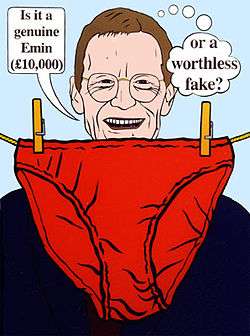Contemporary art
Contemporary art is the art of today, produced in the second half of the 20th century or in the 21st century. Contemporary artists work in a globally influenced, culturally diverse, and technologically advancing world. Their art is a dynamic combination of materials, methods, concepts, and subjects that continue the challenging of boundaries that was already well underway in the 20th century. Diverse and eclectic, contemporary art as a whole is distinguished by the very lack of a uniform, organising principle, ideology, or "-ism". Contemporary art is part of a cultural dialogue that concerns larger contextual frameworks such as personal and cultural identity, family, community, and nationality.
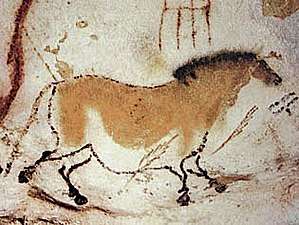 |
| History of art |
| Art history |
In vernacular English, modern and contemporary are synonyms, resulting in some conflation and confusion of the terms modern art and contemporary art by non-specialists.[1]
Scope
Some define contemporary art as art produced within "our lifetime," recognising that lifetimes and life spans vary. However, there is a recognition that this generic definition is subject to specialized limitations.[2]
The classification of "contemporary art" as a special type of art, rather than a general adjectival phrase, goes back to the beginnings of Modernism in the English-speaking world. In London, the Contemporary Art Society was founded in 1910 by the critic Roger Fry and others, as a private society for buying works of art to place in public museums.[3] A number of other institutions using the term were founded in the 1930s, such as in 1938 the Contemporary Art Society of Adelaide, Australia,[4] and an increasing number after 1945.[5] Many, like the Institute of Contemporary Art, Boston changed their names from ones using "Modern art" in this period, as Modernism became defined as a historical art movement, and much "modern" art ceased to be "contemporary". The definition of what is contemporary is naturally always on the move, anchored in the present with a start date that moves forward, and the works the Contemporary Art Society bought in 1910 could no longer be described as contemporary.
Particular points that have been seen as marking a change in art styles include the end of World War II and the 1960s. There has perhaps been a lack of natural break points since the 1960s, and definitions of what constitutes "contemporary art" in the 2010s vary, and are mostly imprecise. Art from the past 20 years is very likely to be included, and definitions often include art going back to about 1970;[6] "the art of the late 20th and early 21st century";[7] "the art of the late 20th cent. and early 21st cent., both an outgrowth and a rejection of modern art";[8] "Strictly speaking, the term "contemporary art" refers to art made and produced by artists living today";[9] "Art from the 1960s or [19]70s up until this very minute";[10] and sometimes further, especially in museum contexts, as museums which form a permanent collection of contemporary art inevitably find this aging. Many use the formulation "Modern and Contemporary Art", which avoids this problem.[11] Smaller commercial galleries, magazines and other sources may use stricter definitions, perhaps restricting the "contemporary" to work from 2000 onwards. Artists who are still productive after a long career, and ongoing art movements, may present a particular issue; galleries and critics are often reluctant to divide their work between the contemporary and non-contemporary.
Sociologist Nathalie Heinich draws a distinction between modern and contemporary art, describing them as two different paradigms which partially overlap historically. She found that while "modern art" challenges the conventions of representation, "contemporary art" challenges the very notion of an artwork.[12] She regards Duchamp's Fountain (which was made in the 1910s in the midst of the triumph of modern art) as the starting point of contemporary art, which gained momentum after World War II with Gutai's performances, Yves Klein's monochromes and Rauschenberg's Erased de Kooning Drawing.[13]
Themes
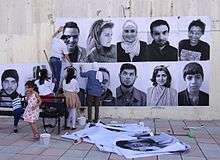
One of the difficulties many people have in approaching contemporary artwork is its diversity—diversity of material, form, subject matter, and even time periods. It is "distinguished by the very lack of a uniform organizing principle, ideology, or -ism"[14] that we so often see in other, and oftentimes more familiar, art periods and movements. Broadly speaking, we see Modernism as looking at modernist principles—the focus of the work is self-referential, investigating its own materials (investigations of line, shape, color, form). Likewise, Impressionism looks at our perception of a moment through light and color as opposed to attempts at stark realism (Realism, too, is an artistic movement). Contemporary art, on the other hand, does not have one, single objective or point of view. Its view instead is unclear, perhaps reflective of the world today. It can be, therefore, contradictory, confusing, and open-ended. There are, however, a number of common themes that have appeared in contemporary works. While these are not exhaustive, notable themes include: identity politics, the body, globalization and migration, technology, contemporary society and culture, time and memory, and institutional and political critique.[15] Post-modern, post-structuralist, feminist, and Marxist theories have played important roles in the development of contemporary theories of art.
Institutions
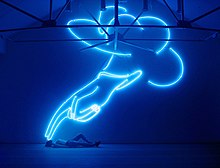

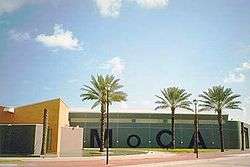
The functioning of the art world is dependent on art institutions, ranging from major museums to private galleries, non-profit spaces, art schools and publishers, and the practices of individual artists, curators, writers, collectors, and philanthropists. A major division in the art world is between the for-profit and non-profit sectors, although in recent years the boundaries between for-profit private and non-profit public institutions have become increasingly blurred. Most well-known contemporary art is exhibited by professional artists at commercial contemporary art galleries, by private collectors, art auctions, corporations, publicly funded arts organizations, contemporary art museums or by artists themselves in artist-run spaces.[16] Contemporary artists are supported by grants, awards, and prizes as well as by direct sales of their work. Career artists train at art school or emerge from other fields.
There are close relationships between publicly funded contemporary art organizations and the commercial sector. For instance, in 2005 the book Understanding International Art Markets and Management reported that in Britain a handful of dealers represented the artists featured in leading publicly funded contemporary art museums.[17] Commercial organizations include galleries and art fairs.[18]
Corporations have also integrated themselves into the contemporary art world, exhibiting contemporary art within their premises, organizing and sponsoring contemporary art awards, and building up extensive corporate collections.[19] Corporate advertisers frequently use the prestige associated with contemporary art and coolhunting to draw the attention of consumers to luxury goods.[20]
The institutions of art have been criticized for regulating what is designated as contemporary art. Outsider art, for instance, is literally contemporary art, in that it is produced in the present day. However, one critic has argued it is not considered so because the artists are self-taught and are thus assumed to be working outside of an art historical context.[21] Craft activities, such as textile design, are also excluded from the realm of contemporary art, despite large audiences for exhibitions.[22] Art critic Peter Timms has said that attention is drawn to the way that craft objects must subscribe to particular values in order to be admitted to the realm of contemporary art. "A ceramic object that is intended as a subversive comment on the nature of beauty is more likely to fit the definition of contemporary art than one that is simply beautiful."[23]
At any one time a particular place or group of artists can have a strong influence on subsequent contemporary art. For instance, The Ferus Gallery was a commercial gallery in Los Angeles and re-invigorated the Californian contemporary art scene in the late fifties and the sixties.
Public attitudes
Contemporary art can sometimes seem at odds with a public that does not feel that art and its institutions share its values.[24] In Britain, in the 1990s, contemporary art became a part of popular culture, with artists becoming stars, but this did not lead to a hoped-for "cultural utopia".[25] Some critics like Julian Spalding and Donald Kuspit have suggested that skepticism, even rejection, is a legitimate and reasonable response to much contemporary art.[26] Brian Ashbee in an essay called "Art Bollocks" criticizes "much installation art, photography, conceptual art, video and other practices generally called post-modern" as being too dependent on verbal explanations in the form of theoretical discourse.[27] However, the acceptance of non traditional art in museums has increased due to changing perspectives on what constitutes an art piece.[28]
Concerns
A common concern since the early part of the 20th century has been the question of what constitutes art. In the contemporary period (1950 to now), the concept of avant-garde[29] may come into play in determining what art is noticed by galleries, museums, and collectors.
The concerns of contemporary art come in for criticism too. Andrea Rosen has said that some contemporary painters "have absolutely no idea of what it means to be a contemporary artist" and that they "are in it for all the wrong reasons."[30]
Prizes
Some competitions, awards, and prizes in contemporary art are:
- Emerging Artist Award awarded by The Aldrich Contemporary Art Museum
- Factor Prize in Southern Art
- Hugo Boss Prize awarded by the Solomon R. Guggenheim Museum
- John Moore's Painting Prize
- Kandinsky Prize for Russian artists under 30
- Marcel Duchamp Prize awarded by ADIAF and Centre Pompidou
- Ricard Prize for a French artist under 40
- Turner Prize for British artists
- Participation in the Whitney Biennial
- Vincent Award, The Vincent van Gogh Biennial Award for Contemporary Art in Europe
- The Winifred Shantz Award for Ceramists, awarded by the Canadian Clay and Glass Gallery
- Asia Pacific Breweries Foundation Signature Art Prize[31]
- Jindřich Chalupecký Award for Czech artists under 35[32]
History
This table lists art movements and styles by decade. It should not be assumed to be conclusive.
See also
- Acculturation
- Anti-art and Anti-anti-art
- Art:21 - Art in the 21st Century (2001-2016), a PBS series
- Criticism of postmodernism
- Classificatory disputes about art
- List of contemporary art museums
- List of contemporary artists
- Medium specificity
- Reductive art
- Value theory
- Visual arts
Notes
- NYU Steinhardt, Department of Art and Arts Professions, New York
- Esaak, Shelley. "What is "Contemporary" Art?". About.com. Retrieved 28 April 2013.
- Fry Roger, Ed. Craufurd D. Goodwin, Art and the Market: Roger Fry on Commerce in Art, 1999, University of Michigan Press, ISBN 0472109022, 9780472109029, google books
- Also the Contemporary Arts Society of Montreal, 1939–1948
- Smith, 257–258
- Some definitions: "Art21 defines contemporary art as the work of artists who are living in the twenty-first century." Art21
- "Contemporary art - Define Contemporary art at Dictionary.com". Dictionary.com.
- "Yahoo". Archived from the original on 2013-07-20.
- "About Contemporary Art (Education at the Getty)".
- Shelley Esaak. "What is Contemporary Art?". About.com Education.
- Examples of specializing museums include the Strasbourg Museum of Modern and Contemporary Art and Museum of Modern and Contemporary Art of Trento and Rovereto. The Oxford Dictionary of Modern and Contemporary Art is one of many book titles to use the phrase.
- Heinich, Nathalie, Ed. Gallimard, Le paradigme de l'art contemporain : Structures d'une révolution artistique , 2014, ISBN 2070139239, 9782070139231, google books
- Nathalie Heinich lecture "Contemporary art: an artistic revolution ? at 'Agora des savoirs' 21st edition, 6 May 2015.
- Contemporary Art in Context. (2016). Retrieved December 11, 2016
- Robertson, J., & McDaniel, C. (2012). Themes of Contemporary Art: Visual Art after 1980 (3rd ed.). Oxford: Oxford University Press.
- "Largest Art & Language Collection Finds Home - artnet News". artnet News. 2015-06-23. Retrieved 2018-09-10.
- Derrick Chong in Iain Robertson, Understanding International Art Markets And Management, Routledge, 2005, p95. ISBN 0-415-33956-1
- Grishin, Sasha. "With commercial galleries an endangered species, are art fairs a necessary evil?". The Conversation. Retrieved 2019-12-05.
- Chin-Tao Wu, Privatising Culture: Corporate Art Intervention Since the 1980s, Verso, 2002, p14. ISBN 1-85984-472-3
- Jasmin Mosielski, Coolhunting: Evaluating the Capacity for Agency and Resistance in the Consumption of Mass Produced Culturally-Relevant Goods (Ph.D. diss., Carleton Univ., 2012); and Peter Andreas Gloor and Scott M. Cooper, Coolhunting: Chasing Down the Next Big Thing (NYC: AMACOM, 2007), 168-70. ISBN 0814400655
- Gary Alan Fine, Everyday Genius: Self-Taught Art and the Culture of Authenticity, University of Chicago Press, 2004, pp42-43. ISBN 0-226-24950-6
- Peter Dormer, The Culture of Craft: Status and Future, Manchester University Press, 1996, p175. ISBN 0-7190-4618-1
- Peter Timms, What's Wrong with Contemporary Art?, UNSW Press, 2004, p17. ISBN 0-86840-407-1
- Mary Jane Jacob and Michael Brenson, Conversations at the Castle: Changing Audiences and Contemporary Art, MIT Press, 1998, p30. ISBN 0-262-10072-X
- Julian Stallabrass, High Art Lite: British Art in the 1990s, Verso, 1999, pp1-2. ISBN 1-85984-721-8
- Spalding, Julian, The Eclipse of Art: Tackling the Crisis in Art Today, Prestel Publishing, 2003. ISBN 3-7913-2881-6
- "Art Bollocks". Ipod.org.uk. 1990-05-05. Archived from the original on 16 July 2011. Retrieved 2011-08-17.
- "What is Art? | Boundless Art History". courses.lumenlearning.com. Retrieved 2018-05-04.
- Fred Orton & Griselda Pollock, Avant-Gardes and Partisans Reviewed. Manchester University, 1996. ISBN 0-7190-4399-9
- Haas, Nancy (2000-03-05), "Stirring Up the Art World Again". The New York Times, .
- "Signature Art Prize - Home". Archived from the original on 2014-11-06.
- Jindřich Chalupecký Award Archived 2007-09-27 at the Wayback Machine
References
- Smith, Terry (2009). What Is Contemporary Art?. Chicago: University of Chicago Press. ISBN 978-0226764313. Retrieved 26 April 2013.
- Meyer, Richard (2013). What Was Contemporary Art?. Cambridge: MIT Press. ISBN 978-0262135085. Retrieved 26 October 2014.
Further reading
- Altshuler, B. (2013). Biennials and Beyond: Exhibitions that Made Art History: 1962-2002. New York, N.Y.: Phaidon Press, ISBN 978-0714864952
- Atkins, Robert (2013). Artspeak: A Guide To Contemporary Ideas, Movements, and Buzzwords, 1945 To the Present (3rd. ed.). New York: Abbeville Press. ISBN 978-0789211514.
- Danto, A. C. (2013). What is art. New Haven: Yale University Press, ISBN 978-0300205718
- Desai, V. N. (Ed.). (2007). Asian art history in the twenty-first century. Williamstown, Mass.: Sterling and Francine Clark Art Institute, ISBN 978-0300125535
- Fullerton, E. (2016). Artrage! : the story of the BritArt revolution. London: Thames & Hudson Ltd, ISBN 978-0500239445
- Gielen, Pascal (2009). The Murmuring of the Artistic Multitude: Global Art, Memory and Post-Fordism. Amsterdam: Valiz, ISBN 9789078088394
- Gompertz, W. (2013). What Are You Looking At?: The Surprising, Shocking, and Sometimes Strange Story of 150 Years of Modern Art (2nd ed.). New York, N.Y.: Plume, ISBN 978-0142180297
- Harris, J. (2011). Globalization and Contemporary Art. Hoboken, N.J.: Wiley-Blackwell, ISBN 978-1405179508
- Lailach, M. (2007). Land Art. London: Taschen, ISBN 978-3822856130
- Martin, S. (2006). Video Art. (U. Grosenick, Ed.). Los Angeles: Taschen, ISBN 978-3822829509
- Mercer, K. (2008). Exiles, diasporas & strangers. Cambridge, Massachusetts: MIT Press, ISBN 978-0262633581
- Robertson, J., & McDaniel, C. (2012). Themes of Contemporary Art: Visual Art after 1980 (3rd ed.). Oxford: Oxford University Press, ISBN 978-0199797073
- Robinson, H. (Ed.). (2015). Feminism-art-theory : an anthology 1968-2014 (2nd ed.). Chichester, West Sussex: Wiley-Blackwell, ISBN 978-1118360590
- Stiles, Kristine and Peter Howard Selz, Theories and Documents of Contemporary Art, A Sourcebook of Artists's Writings (1996), ISBN 0-520-20251-1
- Strehovec, J. (2020).Contemporary Art Impacts on Scientific, Social, and Cultural Paradigms: Emerging Research and Opportunities. Hershey, PA: IGIGlobal.
- Thompson, D. (2010). The $12 Million Stuffed Shark: The Curious Economics of Contemporary Art. New York, N.Y.: St. Martin's Griffin, ISBN 978-0230620599
- Thorton, S. (2009). Seven Days in the Art World. New York, N.Y.: W.W. Norton & Company, ISBN 978-0393337129
- Wallace, Isabelle Loring and Jennie Hirsh, Contemporary Art and Classical Myth. Farnham: Ashgate (2011), ISBN 978-0-7546-6974-6
- Warr, T. (Ed.). (2012). The Artist’s Body (Revised). New York, N.Y.: Phaidon Press, ISBN 978-0714863931
- Wilson, M. (2013). How to read contemporary art : experiencing the art of the 21st century. New York, N.Y.: Abrams, ISBN 978-1419707537
External links

